Sodium PartyPeriodic Table home.
I'd read about, and heard stories about, throwing sodium into water. It's a classic thing chemistry students do in college, and based on the reports I have been able to find on the internet, they are often drunk at the time.
While anecdotal evidence would suggest that many people have thrown sodium into the lakes and streams of the world, they have been reprehensibly lax in documenting the results. I could find no reliable, and I stress the word reliable, reports on what actually happens. What reports I did find were contradictory: As you will see, I now know why.
I decided I should produce a comprehensive online reference on sodium dropping, with documentation on the size and shape of the chunks, how thrown, and most importantly with videos of the resulting explosions. To do this, I held a Sodium Party. People brought chips and soda and we had a cookout.
The first step was the procurement, through eBay, of three and half pounds of solid sodium metal for about a hundred dollars. This is a decent price for a small quantity like this. Small being a relative term: It's used by the ton in industry, but anything more than a few grams is a dangerous quantity if found in your home. Three and a half pounds is enough, for example, to blow your home to bits under the right conditions.
Next I constructed a patented Sodium Release-o-tron:
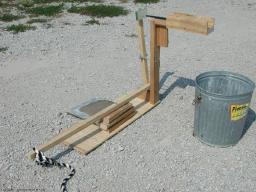
It was designed to be constructed in less than an hour using only things I already had lying around the shop, be very unlikely to go off by accident, and be unable to fail when activated. So far so good.
Here's a picture of the first lump I loaded into it, in a preliminary experiment about a month before the party:
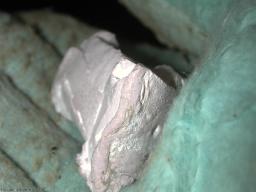
Click here for a video showing how this lump was cut off of the main block: A wood chisel and some pushing is all it takes, because this stuff is very, very soft.
And here's a picture of what happened when we pulled the string:
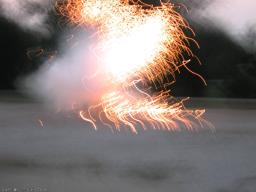
Click here to see a video of this first explosion. (But only if you've got a fast connection, because it's not the best video by far: See below for much better ones if loading these takes time for you.)
This chunk, about 50 grams, gave a surprisingly strong bang, especially considering that there was no containment and no intentional pre-mixing of reactive chemicals, at least one of which is normally a prerequisite for a sharp report.
My theory is that it's a fuel-air explosion caused by mixing of the hydrogen gas with air, ignited a second or two later (as you can see in the video) by the heat that builds up in the sodium. The heating of the sodium acts as the time fuse needed to make any fuel air bomb work. This theory would imply that only a minimal shock wave should be transmitted into the water, since the explosion would be happening well above the surface, as the picture seems to show. Unfortunately that theory is not supported by the fact that the metal bucket was split at the seams, even though less than an inch of rim extended over the level of the water.
Which brings me to a safety warning: Sodium is really rather dangerous. If we had been anywhere within 15 feet of this explosion, it would have sprayed us with molten sodium and sodium hydroxide. Even a tiny amount in the eyes would have been a serious medical emergency. That's why I built a device that let me release it in a very controlled way from a great distance: If you want to do anything even remotely like this, you should take similar precautions. While it's safe to drop a tiny piece, maybe a few millimeters on edge, into a bowl of water, if you are wearing safety glasses, the force of the explosion goes up non-linearly with size. A lot of people have hurt themselves by going to bigger and bigger pieces thinking it's just going to do more of the same. It doesn't: At some point it turns from a fizzle and flame into a real explosion, like a shotgun.
There's also the issue of smoke, of which a lot is produced. I'm not sure what the smoke is, but I suspect it's powdered soda lye (caustic soda, otherwise known as sodium hydroxide), which means you really, really don't want to get in the way of it. Or it could be powdered sodium oxide, which might react over time with carbon dioxide in the air to form sodium carbonate or bicarbonate. I really don't know. But if it is powdered soda lye it would severely burn your eyes, lungs, and skin, and no safety glasses would protect you. Be sure you are upwind.
We had wet down about a 15 foot radius all around, and true to expectations, there were a series of secondary explosions as balls of sodium ejected by the main explosion hit the ground. Unfortunately I was taken aback by the explosion and jerked the camera, so you can't see them. That's one reason the later videos came out better: I used a tripod.
I had planned to hose down and maybe neutralize the driveway the next morning, but in a fascinating display of nature, the driveway was full of little yellow butterflies the next morning.
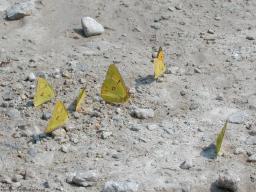
I've read that male butterflies collect sodium as a present for their mates, and they sure seemed to like mine, so I decided to leave it. I'm surprised they liked what must be a fairly basic solution, but then maybe it's just neutralized decades of road acid.
According to the popular radio entomologist May Berenbaum from the University of Illinois, I was right about the butterflies. She writes:
"They're called sulfur butterflies (in the family Pieridae) and the general consensus is that they are indeed after sodium, which is transferred to females in the spermatophore or sperm package.
Here are some references about the phenomenon:
Adler, P. and D. Pearson, 1982. Why do male butterflies visit mud puddles? Can. J. Zool. 60: 322-325.
Arms, K., P. Feeny and R.C. Lederhouse, 1974. Sodium: stimulus for puddling behavior by tiger swallowtail butterflies, Papilio glaucus. Science 185: 372-374.
Smedley, S. R. and T. Eisner 1996. Sodium--a male moth's gift to its offspring. Proc. Nat. Acad. Sci. 93:809-13.
There's something intensely sad about this. These tiny creatures have nothing to give but a little package of sodium, but this they give with all their heart. It is their life, their hope, their future, and they give it, asking nothing in return, that their children might have a better start in life. I suppose it should be uplifting, but somehow it just seems terribly sad to me.
Moving on, I still needed to work out the details of my Sodium Party. The classic thing to do with sodium is to throw it in a lake. I own a lake. It's obvious what to do, right? Actually, it's not that simple. For one thing, I care a great deal about the fish and frogs in my lake, and don't wish to poison or shock them. Sodium certainly isn't poisonous, but it could raise the pH measurably, even in my acre and a half lake (I did the math). More of a problem would be intense shock waves. After all, fishing with dynamite is a redneck tradition, and I don't allow fishing in my lake, even by me.
There was also that phone call from the Illinois Environmental Protection Agency, which somehow got wind of my idea. They believe that sodium is a caustic waste material which may not be dumped into the waters of the state in any quantity. I question that on two grounds, first I question that there is no lower reporting limit on sodium, and second I question that my lake is a water of the state. Having worked as a volunteer for an environmental water quality watchdog organization, and having spoken with several people there about this, I think I'm almost certainly right in believing that I have the legal right to dump a few ounces of sodium into my private lake if I so choose. The representative of the IEPA, however, disagreed with me on that conclusion.
Fortunately, no constitutional crisis developed out of this impasse, because by the time he put is foot down, I had already decided that I really didn't want to place my fish in harms way anyway.
The day before the party a few intrepid souls came out to test my ingenious workaround. I cleared a small floating deck, put a tarp over it with edges so I could flood the whole thing with about an inch of water, and put a small kids swimming pool full of water in the middle. Then I anchored the whole thing out in the middle of the lake with the sodium release-o-tron on it.
I loaded the machine with a 109.5 gram solid lump of sodium (about twice as big as the piece in my first experiment on land), rowed away, and started the cameras rolling.
The idea was that the sodium would explode in the pool, and at most a trivial amount would escape to the surrounding lake, where it would be instantly vaporized. I could then neutralize the pool water with a touch of hydrochloric acid ("Muriatic acid" at any hardware store), leaving only slightly salty water in the pool. (Sodium goes to hydrogen gas plus sodium and hydroxide ions in the water. Hydrochloric acid is chlorine and hydrogen ions: The hydrogen ions combine with the hydroxide ions to form water and neutralize the pH, while the sodium and chlorine ions are what is more commonly known as dissolved table salt. Not even the IEPA, I believe, has a regulation against dumping slightly salty water.)
But that's not quite how it worked out. There was an initial large explosion:
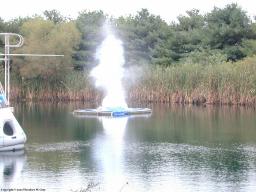
Then there were a series of secondary explosions obviously caused by a single fairly large chunk that was literally hopping across the lake. It was thrown high up into the air, came down to hit the water at a high rate of speed, and was then thrown back up into the air by the resulting explosion. This happened at least three, maybe four times, so far as I can tell from the video.
This is quite alarming: The longest time between impacts, timed on the videotape, was 3.12 seconds. If you do the math, this means the chunk was thrown almost 40 feet high. Fortunately it was going reasonably close to straight up and down, and we were quite far away (about 200 feet). But this skipping behavior, which so far as I know is documented here for the first time on the internet, clearly gives the whole thing far greater potential reach. It's easy to imagine a chunk skipping hundreds of feet.
I think this skipping behavior is one reason reports on what happens to sodium when you throw it in water are so varied and contradictory. As you will see in the videos below, it varies tremendously depending on the size of the chunk, how hard it hits the water, how deep the water is, and probably on the temperature of the air and water.
Very small pieces skid around and may or may not burn, but don't generally explode. Larger pieces explode and disintegrate themselves. Still larger pieces explode but stay intact, ejecting a solid chunk high into the air. Of course when the chunk comes back down, it's anyone's guess what happens next.
If someone were to throw a chunk like this (about three ounces) by hand into a lake, it could very easy come back and hit them. This video tape clearly demonstrates that sodium can throw itself farther than you can. And more ominously, you can clearly see on at least one of the jumps that it tends to come back at the direction it was thrown from. My theory is that when it hits the water it forms a cavity as it plunges down. This cavity acts like a cannon barrel to direct the chunk back in the direction it came from, when the steam and evolved hydrogen explode.
For this reason, I think a repeat of this method of deployment would be ill advised. It simply isn't predictable enough to be safe. When the pool is surrounded by wet driveway, there's no obvious way for chunks to skip long distances, and that's the way I decided to do it for the main party.
On the day of the party I set up the Release-O-Tron at one end of our parking lot, and laid out a pair of hoses connected to the well pump in the lake (which provides an endless supply of water). I ran the hoses for about an hour to get the whole gravel area wet down, and they were left running most of the time, to keep a good puddle about 40-50ft in diameter around the swimming pool.
Starting around 5:30 we set off a bunch of explosions, using a variety of different sizes and configurations of sodium, during daylight and night time. Some were solid chunks, others were cut up into sugar-cube sized bits:
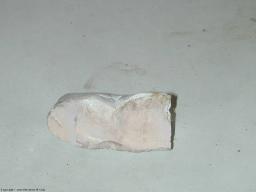 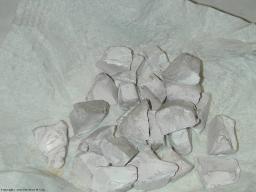
Since posting this website, I have gotten several great stories from people who have done sodium experiments. Here are some of the best:From Bob E: Apocalypse on Lake Texoma
From Rick Manley: Fire from the Sky
From Paul: A Shimmering Ball
From Anonymous: Cold War Paranoia
From Dan Rabin: Sodium in Fiction
From D'John: Potassium for a change
From Anonymous: The Famous MIT sodium throw, with video!
From Jon: The Incredibly Dangerous Kawasaki Escapade
From Graham Ford: Graham's containment story
From M. Otis Beard: How to get out of a sticky situation
From Anonymous: Surplus danger
From Robin Carter: Toilet Humor
From Anonymous: Icecapades
From Roger Diggle: The Boy Scout Fire Starting Method
From Andrew Pullen: Why you shouldn't use sodium and white phosphorus at the same time
From Scott: Scrap Sodium
From Joe: Sodium + Toilet = Danger If you have a sodium story, please send it to me.
Still, the only videos I could find were of pathetic thumbnail-sized bits skidding about in a bowl (see my version below, but trust me, it's really boring). So without further ado, here are my sodium videos, in chronological order. Click on the picture to see the corresponding movie.
(All the videos on this page are now hosted by google's video service: You'll need the Flash player installed, which should be automatic if you have a reasonably modern browser.)
|  | |  | | | Sample Image | Movie Size | Description | 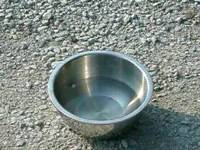 | 452KB | About one gram chip in a bowl. Boring. This is the experiment that makes a lot of people try bigger pieces, thinking that they will get more of the same. Instead they get an explosion they weren't expecting. Unless, of course, they've visited this web page. | 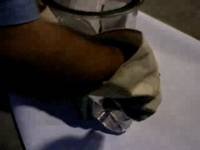 | 4.6MB | How to cut up sodium with a chisel. Wear gloves and safety glasses. | 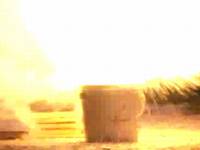 | 2.5MB | Our first explosion, about 50 grams in one piece. I jerked the camera. Very Blair Witch. |  | 4.7MB | Our second explosion, in a tub floated on the lake. 109.5 gram single piece. | 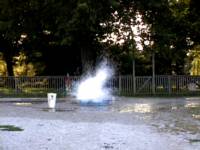 | 3.7MB | First explosion of the party, done during daylight because some people had to leave early. A small 18.5 gram solid piece. |  | 3.9MB | In this explosion we cut up 59.0 grams into sugar-cube-sized chunks to see if it made a difference. I think this configuration gives the most pleasing explosions. | 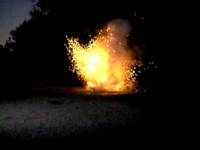 | 10.4MB | 151.5 grams cut into cubes. This is one of the best videos. | 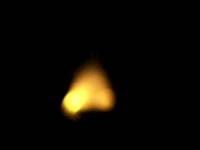 | 1.2MB | 70.8 grams in one piece. This video is included for documentary completeness only: It's out of focus and not really worth watching. | 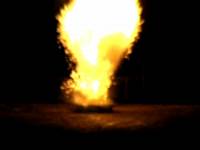 | 1.8MB | 83.5 grams in one piece. This video is included for documentary completeness only: It's out of focus and not really worth watching. | 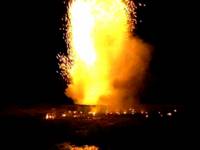 | 3.8MB | 145.0 grams cut into cubes. This is probably the best video of the lot. | 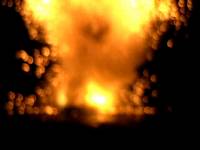 | 2.2MB | 119.5 grams in one piece. This video is somewhat out of focus, but it's a huge explosion to somewhat worthwhile to watch. | 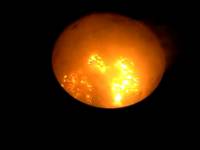 | 21.4MB | In this video we used a propane torch to light about 10 grams of it in a bowl, to see how it would burn. It burns sort of like magnesium, but easier to light. Sodium burning in air is very gentle, slow, controlled. Try to put it out with water and you're in big trouble. | 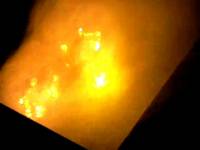 | 13.8MB | More burning in air, about 50 grams this time. We used a stick to stir it, and the stick started burning like a fuse, probably because of moisture in it. | 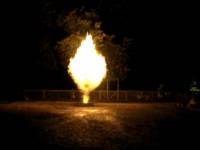 | 2.3MB | 87.5 grams in one piece. |  | 1.0MB | Our biggest chunk ever: 175.0 grams in one piece, dropped in a bucket in the pool. It shot up like a rocket and landed on the driveway largely intact. |  | 12.7MB | This video shows us tracking down and detonating the stray chunk from the last explosion. Ed and I sprayed it from a distance with water hoses. The video starts slow, but gets more interesting as it goes on. |
|
| |  | |  |
|
Since posting this page, my sodium party has generated a considerable amount of interest from people not normally interested in chemistry. There were several postings on slashdot.org that brought my server to its knees each time. There was a very nice article in my hometown newspaper, and it was even mentioned in a prominent Men's magazine of all places.
Click here for a gallery of pictures from the party.
|
|